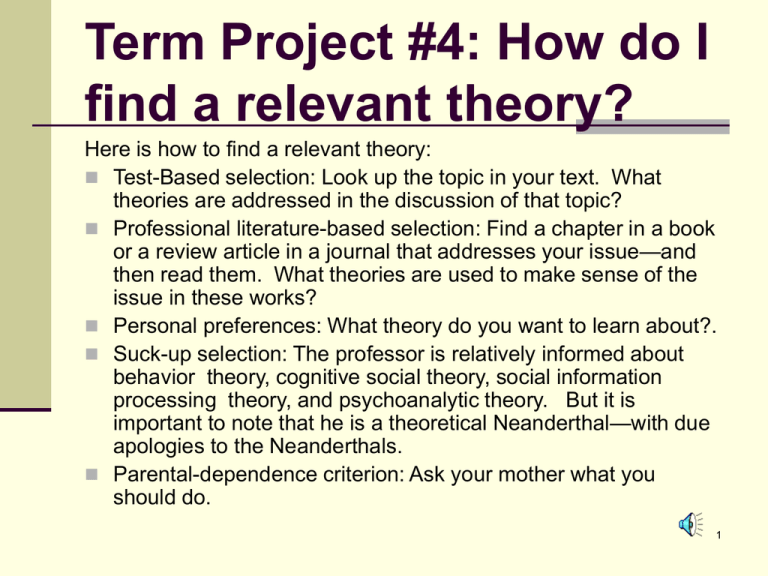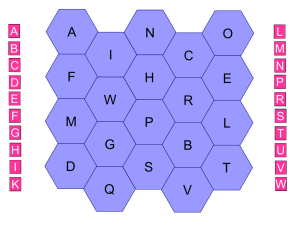
Term Project #4: How do I
find a relevant theory?
Here is how to find a relevant theory:
Test-Based selection: Look up the topic in your text. What
theories are addressed in the discussion of that topic?
Professional literature-based selection: Find a chapter in a book
or a review article in a journal that addresses your issue—and
then read them. What theories are used to make sense of the
issue in these works?
Personal preferences: What theory do you want to learn about?.
Suck-up selection: The professor is relatively informed about
behavior theory, cognitive social theory, social information
processing theory, and psychoanalytic theory. But it is
important to note that he is a theoretical Neanderthal—with due
apologies to the Neanderthals.
Parental-dependence criterion: Ask your mother what you
should do.
1
Psychology 1230:
Psychology of
Adolescence
Don Hartmann
Fall 2005
Lecture 4: Introduction to Theory
2
Administrative Announcements
If you have added the class after 08-25 (Thursday), please let
me know, for example, via email.
My thanks to all of you who completed an application for class
TA. The class TAs for this semester are as follows:
Holly Ausbeck
Michael Iwasaki
Sean Paul
Megan Rae
Jessica Whipple
3
Discussion Topic #1
#1 Choose your Theorist: Whippets I (SummaryEvaluation due on Monday, Sept. 12). Assume that
you were teaching psychology to a group of high
school sophomores, and you could only talk with
them about a single theorist. Of the major theorists
discussed in chapter 2 of our text, which theorist
would you choose, and why? Also comment critically
on at least one other discussant’s choice.
4
Discussion Topic #2
#1b Being a Wise Consumer of Research on
Adolescence: Hotties I (Summary-Evaluation due on
Tuesday, Sept. 13th). Our text describes a variety of
guidelines/caveats regarding media reports about
adolescents. Take some story you have recently
read or seen reported, and describe which of the
cautions mentioned in the text apply. Be sure to
describe the story in sufficient detail so that your
reader will understand how the caution(s) applies.
You also may want to reply to another discussant’s
remarks.
5
WEB Discussion Process
Group
Whippets
Hotties
#1 due #2 due #3 due #4 due #5 due
09/12
09/13
---------Note: Anyone can contribute to any WEB discussion; group members are
responsible to summarizing the discussion. The last day to contribute to
any discussion is 3 days before the due date.
6
Handout Summary
4.
5.
6.
7.
8.
9.
10,
11.
12.
13.
14.
15.
16.
17.
HO-Inform. Sheet*
HO-TA Application*
Lect. #1b: How to succeed
HO-Class Participation*
HO-WEB Discussions*
HO-TA Rank Order
HO-Term Paper*
Lect. #2: Historical Perspect.
HO-Suppl. Proj. #1*
Lect. #3: Devel. Issues
HO-Completing a Film Review*
HO-Preparing a Book Review
Completed Class Locator
Lect. #4: Introduction to Theory
Handout
WEB
Date
Date
08/24
08/24
08/05
08/05
08/11
08/05
08/05
08/14
08/12
08/12
08/12
08/15
08/14
08/14
08/26
08/31
08/31
----*Indicates handouts discussed in class.
7
Overview
•Introduction to Theory: Lecture #4
•Brief introduction to HO-Film Reviews
•Completion of Lecture #3 on
Developmental Issues
•What is theory?
•The value of theory
•The Story of Dickie & Johnnie
•According to Piaget
•According to Freud
•According to Bandura
•Next: Bandura’s Social Cognitive Theory
8
HO-Film Reviews: I
Films on adolescence can be viewed, reported on, and reviewed for extra
credit. A finely done review might garner up to 4 extra-credit points. To
complete a review, view the film, complete the report/review and hand it
in or email it to the instructor. Your paper should have most of the
following components.
Cover page: Your name, class for which review was conducted, date
review was handed in, film title and date film was viewed.
Body of review:
Descriptive information on the film, including length, year of release,
director, major players, and where available.
Psychological information on the film including adolescent issues dealt
with, implicit theory of adolescent behavior, and for whom film is
appropriate.
Your assessment of the value of the film on any and all dimensions
you think appropriate.
Films previously reviewed include Whale Rider, Saved, Thirteen, L.I.E.,
Antwone Fisher, &Brotherhood of Man.
-----Note: the handout on book reviews looks quite similar to the one on
9
films.
Film Reviews: II
Tentative Evaluation Form for Film Reviews
Name:_________________________
Date:
_______________
Name of Film: __________________________________
__Cover sheet (0-.5)
__Review (0-3.5)
__Descriptive information (0-.5)
__Psychological information (0-1)
__Assessment (0-1)
__Writing (0-1)
__Total
Comments:
10
Ruth Benedict’s Cultural
Commentary
Importance of the structure and
demands of a society
Conflict over a behavior varies with
degree to which the socialization practices
enforce substantial discontinuities in
expectations, and
the degree to which these discontinuities are
associated with unclear cues
11
Early versus Continuous
Development
Is the course of development set during the formative
years?
OR
Is development non-selective as to when it occurs?
Related to Critical or Sensitive Period
Hypothesis
Examples: imprinting (Lorenz’s goslings)
Freud’s theoretical notions about the formative
years (1-3)
12
Imprinting? Lorenz Who?
When Imprinting
Studies Go Awry!
13
Supplementary References
Thomas, R. M. (2001). Recent theories of human
development. Thousand Oaks, CA: Sage
Publications.
Miller, P. H. (1993). Theories of developmental
psychology (3rd ed.). New York: W. H. Freeman &
Company.
Initials
only
Edition
in
brackets
Title in
italic
City of
publication
14
And some theories are more
important than others…
15
What are Theories?
Kurt Lewin: “Nothing is so practical as good
theory” (1951, p. 169).
What are they? Stories (explanations) of how the facts
fit together
Indicate which facts are important…
Which sorts of relationships among the facts are
most important for producing understanding…
Theories give facts meaning…“Without theory, facts
remain a clutter of disorganized specks on the
canvas, unconnected spots that form no picture of
how and why children grow up as they do”…
16
Life Without Theories
17
Life With Theories
18
A Vignette Illustrating the Value of
Theory: Little Johnnie
Little Johnnie takes his fluffy,
stuffed doll to bed with him, hugs
and kisses it, and says "Dickie
loves Johnnie" (the stuffed doll
loves him).
19
Piaget: Dickie loves
Johnnie
Important facts? Piaget has not
much to say about sexual behavior
or affection. Would focus on:
the child has language;
child confuses self with object
How do the facts inter-relate? Piaget would
state that actions (verbal behavior) reflects
stage of thinking--in this case, egocentric
thought
20
Freud: Dickie loves
Johnnie
Facts of interest?
Eros: affect ional and/or sexual behaviors
Same sex of agent and recipient
Interrelation?
Child distinguishes between self and others, but only
incompletely (ego is not completely formed)
Evidence of projection (I don't love you; you love me),
one of classic defense mechanisms
Child has NOT had libido suppressed by punishment
for affection
21
Bandura: Dickie
Loves Johnnie
Facts?
Object taken to bed
Affectional responses
Language use
Agent-recipient relationship
Inter-relate?
What has Johnnie been observing in his
home -- affection (imitation)
What has Johnnie been reinforced for? Acting
affectionately.
Johnnie perhaps thinks of himself as an affectionate
person (self-concept)
22
The MAN!
23
Introduction to the Man
4th most influential psychologist
of the 20th century (see my bulletin board)
Distinguished Professor at Stanford
Past President of the American Psychological
Association (APA)
On this campus, mentor of Donna Gelfand & Don
Hartmann
An important advocate and developer of Social
Learning Theory, which has been transformed into
Social Cognitive Theory
24
The Characteristics of Bandura’s (early)
Theory with Emphasis on Learning
Early version (Social Learning Theory)
emphasized the means by which we acquire
behavior: Learning…
Operant Conditioning—behavior controlled by its
consequences
Classical (Pavlovian) Conditioning (Why we salivate
when we hear bells.)
But especially, IMITATION
25
More on Imitation as a
Process
Basic rather than derived process
More efficient alternative to shaping—
response acquisition mechanism
emphasized by Skinnerians
Has elaborate theory of the process of imitation
learning.
26
The Process of Imitation involves…
Attending to the “model”
Coding the behavior into memory
Retrieving the behavior from memory
Performance of the modeled behavior, and
The role of incentives
27
Imitation May Not Always Be
Desirable
28
More on the Characteristics of Bandura’s
(early) Theory with Emphasis on Learning
Distinguished between learning &
performance
We often, and incorrectly,
infer what an individual knows from
what that person does
29
Learning Vs. Performance
30
Still More of the Characteristics of
Bandura’s (early) Theory with Emphasis on
Social Context
Both early version (Social Learning Theory) and
later version (Social Cognitive Theory)
emphasized the social context in which learning
occurred
Social variables are important in determining
what we learn, how much, etc.
31
Bandura: Nurture over Nature
From Bandura: In lower mammalian species, for
example, sexual activities are completely regulated
by gonadal hormones; among primates sexual
behavior is partially independent of physiological
stimulation; while human eroticism is exceedingly
variable and essentially independent of hormonal
regulation....thus, one would induce sexual
behavior in a rodent Don Juan by administering
androgen, whereas presenting him lascivious
pictures of a well-endowed mouse would have
no stimulating effects whatsoever. By contrast,
one would rely on sexually-valenced social stimuli,
rather than on hormonal injections for producing
erotic arousal in human males.
32
Summary
Theory
The
value of theory
Dickie & Johnnie
Introduction to Bandura
Early
Social learning theory
Next: More on Bandura (#5)
Go in Peace!
33






